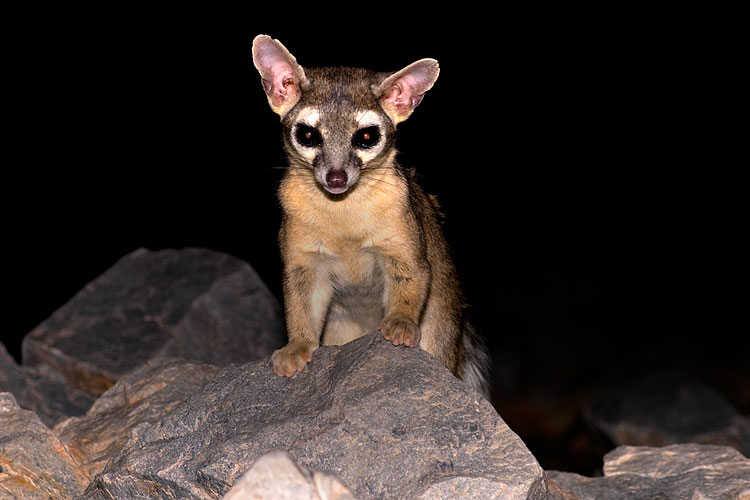The ringtail cat (Bassariscus astutus) is a small, elusive member of the raccoon family that can be found in the western U.S. and as far east as Oklahoma.
The animal gets its name from the seven or eight well-defined black rings on its bushy tail and its slender body shape that resembles that of a cat. The ringtail has also been referred to as a miner’s cat. Even though they prefer to avoid humans, ringtails can be socialized and were used as pets by 19th and early 20th century Nevada miners to keep rodents under control.
Weighing only 1-3 pounds, the ringtail has large black eyes surrounded by a ring of light-colored fur. The body is light to dark brown body with a white belly and is about 14 inches long with the ringed tail extending another 8-10 inches.
The ringtail’s narrow muzzle and long whiskers give it the facial features of a fox, which accounts for its Latin name Bassaricus astutus, clever little fox.

Ringtails are remarkable climbers. Using their long tails for balance, their short retractable claws, and rear feet that can rotate 180 degrees, they can easily navigate trees and narrow rock ledges. The envy of rock climbers worldwide, ringtails can also “chimney stem” crevices. By pressing all four feet against one wall and its back against the other wall, the ringtail can shimmy up and down cracks with ease.
The ringtail is primarily a nocturnal predator who uses its oversized eyes and large pupils to gather as much light as possible while on the hunt. Its prey mainly consists of insects, mice, squirrels, birds, lizards, frogs, and fruit.
A ringtail can survive for long periods without access to water by utilizing water ingested from its food. Its urine is highly concentrated which allows it to maximize water retention and thrive in arid environments.
The ringtail prefers a reclusive life in the forests and rocky areas of arid regions. A male ringtail’s territory is typically 50-100 acres and has strategically placed feces to mark its borders.
Although ringtails prefer a solitary existence, they do start to get more social in February and March when the annual mating season begins. The female creates a den in a tree hollow, mine shaft, or abandoned wooden structure during the 50-day gestation period. The male continues to hunt and provide food for the female until the cubs are weaned. Each litter will have 2-4 hairless cubs who will be cared for by the mother until they are weaned at four months and begin to hunt for themselves. The young ringtail will reach sexual maturity in about 10 months.

Due to their climbing agility, most ringtails are able to avoid being eaten by coyotes, bobcats and other terrestrial-based predators. When threatened, the ringtail will make a high-pitched scream and bristle its tail hair and arch it over its back to look more threatening. If the situation is dire enough, the ringtail will secrete a nasty-smelling juice from its musk glands to deter the predator.
Ringtails do, however, succumb to predation by airborne hunters like the Great Horned Owl or Red-Tailed Hawk. If a ringtail doesn’t end up on a raptor’s menu, it can live up to seven years in the wild.




